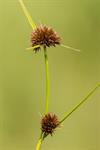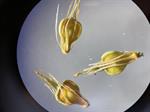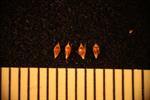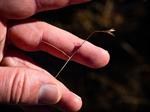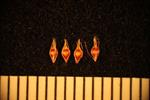Click the number at the start of a key lead to highlight both that lead and its corresponding lead. Click again to show only the two highlighted leads. Click a third time to return to the full key with the selected leads still highlighted.
1 Bristles 8-25, retrorsely barbed distally, antrorsely barbed proximally; spikelets white, turning tan with age. |
..2 Spikelets with 2-3 florets; bristles 8-12; achene 1.6-2.1 mm long, 0.9-1.3 mm wide |
..2 Spikelets with 1 floret; bristles 16-25; achene 2.0-2.4 mm long, 1.3-1.5 mm wide |
1 Bristles 6 or fewer, either retrorsely or (rarely) antrorsely barbed their entire length; spikelets variously brown, rufous, or tan (or very rarely white). |
....3 Spikelets 1-fruited, the solitary achene terminating the axis; clusters 1-7, globose to turbinate. |
......4 Achene body 1.3-2.0 mm long, 0.8-1.1 mm wide; tubercle 0.9-1.8 mm long. |
........5 Clusters turbinate to hemispheric (rarely subglobose), the lowest spikelets usually spreading-ascending to spreading; larger leaves usually < 2 mm wide; achene 1.5-2.0 mm long; tubercle 1.0-1.6 mm long |
........5 Clusters globose to subhemispheric, the lowest spikelets usually reflexed; larger leaves usually > 2 mm wide; achene 1.3-1.9 mm long; tubercle 0.9-1.8 mm long |
......4 Achene body 1.7-2.4 mm long, 1.1-1.8 mm wide; tubercle 1.4-2.7 mm long. |
..........6 Clusters 7-14, turbinate; achene 1.9-2.1 mm long, 1.1-1.2 mm wide; tubercle 2.3-2.7 mm long, exceeding body length |
..........6 Clusters 1-7, globose to hemispheric; achene 1.8-2.6 mm long, 1.1-1.8 mm wide; tubercle 1.4-2.4 mm long, shorter than to equaling body length. |
............ 7 Achene 1.1-1.2 mm wide, 1.7-1.9 long; tubercle 1.4-1.8 mm long; heads hemispheric |
............ 7 Achene 1.4-1.6 mm wide, 2.0-2.4 mm long; tubercle to 2.4 mm long; heads globular |
....3 Spikelets 1-5 fruited (if 1-fruited, then the axis terminated by a sterile floret); clusters 2-many, ovoid to turbinate (rarely globose). |
............ ..8 Clusters numerous, usually 20 or more; tubercle 1.3-1.8 mm long; achene 0.9-1.5 mm wide, 1.5-2.0 mm long, the summit narrowly truncate, the faces umbonate, the margin thickened and wire-like; leaves 2.5-7 mm wide. |
............ ....9 Achene face medium brown, body 0.9-1.1 mm wide, the expanded portion above the gynophore 1.0-1.1 mm long, the gynophore slender and long |
............ ....9 Achene face dark brown, body 1.2-1.5 mm wide, the expanded portion above the gynophore 1.3-1.4 mm long, the gynophore thick and short |
............ ..8 Clusters 2-8; tubercle 0.4-1.2 mm long; achene 0.6-1.2 mm wide, 1.1-2.0 mm long, the summit more rounded than truncate, the faces lenticular, a wire-like margin narrow or not evident; leaves 0.2-3.5 mm wide. |
............ ......10 Achene 0.6-0.8 mm wide, 1.1-1.3 mm long; tubercle 0.4-0.6 mm long; bristles more-or-less equaling the achene; [Endemic to NJ and historically also DE] |
............ ......10 Achene 0.8-1.2 mm wide, 1.3-2.0 mm long; tubercle 0.8-1.6 mm long; bristles more-or-less equaling the tubercle; [collectively widespread]. |
............ ........11 Inflorescence typically with 1 terminal and 1 lateral cluster, the clusters ovoid, with 1-10 spikelets each; achene 1.8-2.0 mm long, 0.8-1.0 mm wide, 2-3 × as long as wide; leaves 0.2-0.4 mm wide |
............ ........11 Inflorescence with 1-6 lateral clusters, the clusters turbinate with usually > 10 spikelets; achene 1.3-1.8 mm long, 0.9-1.2 mm wide, 1.5-2 × as long as wide; leaves 1.5-3.5 mm wide. |
............ ..........12 Longer bristles 0.4 mm shorter than to 0.3 mm longer than the tubercle; tubercle 0.9-1.4 (-1.6) mm long, on average 0.69× as long as achene body; glomerules 3-5 (-6), 6-13 mm wide; [widespread in our area] |
............ ..........12 Longer bristles 0.3-1.0 mm longer than the tubercle; tubercle 0.8-1.1 mm long, on average 0.57× as long as achene body; glomerules 4-8, 4-8 mm wide; [of the Coastal Plain] |
1 Bristles 12; [section Fasciculares] |
|
..2 Leaves with a short taper at the tip, blunt to acute, but not long-acuminate; achene surface minutely pitted near the margin; [section Chapmaniae]. |
....3 Basal leaves 4-6 mm wide, ciliate, rosulate; scales acuminate, the midrib ciliate; bristles 6, < ½ the length of the achene; achenes 1.6-2 mm long; [widespread in mesic to wet pinelands from VA s. to FL, w. to e. LA] |
....3 Largest basal leaves 2.5-3 mm wide, eciliate, not rosulate; scales aristate, the midrib eciliate; bristles 3-4, 1 or more equaling or exceeding the tubercle; achenes (1.4-) 1.5-1.7 (-1.9) mm long; [rare, s. GA, disjunct in se. SC] |
..2 Leaves long-acuminate at the tip; achene surface smooth or finely striate. |
......4 Bristles absent or 1-3 rudimentary; scales white to pale tan (or pale reddish-brown in R. brachychaeta); [section Chapmaniae]. |
........5 Inflorescence composed of (1-) 2-3 turbinate to ellipsoid clusters; spikelets pale reddish-brown, (2.7-) 3-3.5 mm long; achenes usually 2 per spikelet |
........5 Inflorescence composed of 1 (-2) hemispheric to broadly turbinate cluster(s); spikelets white to pale brown, either 2-2.5 (-3) mm or (3.5-) 4-5.5 mm long; achenes 1 per spikelet. |
..........6 Base of plant not bulb-like, not enclosed in bladeless sheaths; spikelets 2-2.5 (-3) mm long; achene 1.0-1.2 mm long, 0.8-1.0 mm wide |
..........6 Base of plant bulb-like, enclosed in bladeless sheaths; spikelets (3.5-) 4-5.5 mm long; achene 1.4-1.8 mm long, 1.2-1.5 mm wide |
......4 Bristles present (if rudimentary, then 4-6); scales tan, rufous, or brown. |
............ 7 Achene 0.6-1.1 mm wide, pyriform, obovoid, or narrowly elliptic, pale to dark brown but not blackish; tubercle margin setose. |
............ ..8 Inflorescence of 1 cluster; tubercle 0.3-0.4 mm long, the margin smooth |
............ ..8 Inflorescence of (1-) 2-4 (-10) clusters; tubercle 0.4-1.4 mm long, the margin setose; [section Fuscae]. |
............ ....9 Achene narrowly elliptic or narrowly obovoid, 1.2-1.5 mm long by 0.6-0.7 mm wide, twice as long as wide; tubercle 0.8-1.2 mm long |
............ ....9 Achene broadly elliptic to obovoid or pyriform, < 2× as long as wide; tubercle 0.4-1.5 mm long. |
............ ......10 Leaves 2-4 (-5) mm wide; stipe subtending achene 0.5-1.0 mm long |
............ ......10 Leaves 0.2-1.5 (-2) mm wide; stipe subtending achene < 0.4 mm long. |
............ ........11 Leaves to 1.5 (-2) mm wide; achene 1.0-1.7 mm long, 0.9-1.1 mm wide; tubercle 0.5-1.5 mm long, triangular-subulate, the margins typically conspicuously concave. |
............ ..........12 Culms solitary to loosely cespitose by slender rhizomes; terminal internode straight; clusters turbinate to ovoid; achene 1.0-1.3 mm long, uniformly medium to dark brown; tubercle 0.7-1.5 mm long; bristles usually of two lengths, some equaling the tubercle, and some equaling or shorter than the achene |
............ ..........12 Culms solitary to cespitose, without slender rhizomes; terminal internode often arched; clusters corymbose to hemispheric; achene 1.3-1.7 mm long, pale to reddish-brown, often translucent centrally, with a distinctly thickened wire-like margin; tubercle 0.5-1.0 mm long; all bristles more-or-less equaling the tubercle |
............ ........11 Leaves filiform, < 1 mm wide; achene 0.8-1.3 mm long, 0.6-0.9 mm wide; tubercle 0.4-0.8 mm long, deltoid to triangular-subulate, the margins flat to concave. |
............ ............ 13 Plants with delicate, long-creeping rhizomes; spikelets 5-7 mm long; achene uniformly opaque; tubercle 0.6-0.8 mm long |
............ ............ 13 Plants without rhizomes; spikelets 2.5-5 mm long; achene translucent centrally; tubercle 0.4-0.7 mm long. |
............ ............ ..14 Achenes 1.5-1.9 mm long, 0.5-0.8 mm wide; stipes 0.2-0.3 mm long; tubercles 0.4-0.6 mm long |
............ ............ ..14 Achenes 2.1-2.3 mm long, 0.8-0.9 mm long; stipes 0.3-0.4 mm long; tubercles 0.6-0.7 mm long |
............ 7 Achene > 1 mm wide (except 0.8 mm wide in R. fernaldii with a blackish surface), suborbicular or broadly ellipsoid; tubercle margin smooth or roughened but not setose; [section Fasciculares]. |
............ ............ ....15 Achene 0.9-1.0 mm long, 0.8 mm wide, blackish |
............ ............ ....15 Achene 1.3-4.2 mm long, 1.1-3.6 mm wide, brown to dark brown. |
............ ............ ......16 Achene 2.0-4.2 mm long, 2.0-3.6 mm wide. |
............ ............ ........17 Leaves 2-4 mm wide; achene 2.0-2.7 mm long, 2.0-2.5 mm wide |
............ ............ ........17 Leaves 4-8 mm wide; achene 3.0-4.2 mm long, 3.0-3.6 mm wide |
............ ............ ......16 Achene 1.3-2.0 mm long, 1.1-1.7 mm wide. |
............ ............ ..........18 Tubercle 1.0-2.6 mm long, long-attenuate to subulate |
............ ............ ..........18 Tubercle 0.2-0.8 mm long, triangular to triangular-attenuate or with a strap-like beak. |
............ ............ ............ 19 Bristles rudimentary to ½ as long as the achene body. |
............ ............ ............ ..20 Larger leaves to 1 mm wide; mature culms to 4.5 dm long; floral fascicles 1 (-2); tubercle 0.2-0.5 mm long |
............ ............ ............ ..20 Larger leaves 2-4 mm wide; mature culms to 13 dm long; floral fascicles (1-) 2-4; tubercle 0.4-0.7 mm long |
............ ............ ............ 19 Bristles > ½ as long to exceeding the achene body. |
............ ............ ............ ....21 Basal leaves filiform to (rarely)1.3 mm wide, the longer approaching length of culm; tubercle narrowed above the base into a strap-like beak |
............ ............ ............ ....21 Basal leaves 1.3-4 mm wide, all much shorter than the culm; tubercle triangular to triangular-attenuate. |
............ ............ ............ ......22 Longer bristles equaling to exceeding the achene body; achene body elliptic, 1.1-1.3 mm wide; tubercle triangular-attenuate; larger basal leaves 1.3-2.5 mm wide |
............ ............ ............ ......22 Longer bristles < ½ as long to exceeding achene body; achene suborbicular, 1.2-1.5 mm wide; tubercle triangular; larger basal leaves 2-4 mm wide |
1 Bristles absent (or apparently so at 10×); achene 0.5-0.7 mm wide; tubercle 0.1-0.2 mm long, skull-cap like; [section Pusillae]. |
..2 Achene including tubercle 1.0-1.2 mm long, the achene surface evidently reticulate and obscurely transversely ridged, the body ellipsoid; bristles present, white, barely visible at 20×, the longest shorter than the achene body |
..2 Achene including tubercle 0.6-0.9 mm long, the body obovoid; bristles absent. |
....3 Achene surface smooth, faintly reticulate, not transversely ridged |
....3 Achene surface rough, distinctly transversely ridge |
1 Bristles present or absent; if absent, then the achene > 1 mm long or > 0.7 mm wide, and tubercle triangular to subulate. |
......4 Culms and leaves filiform. |
........5 Achene including tubercle 1.0-1.2 mm long; tubercle minute, skullcap-like; [section Pusillae] |
........5 Achene including tubercle 1.5-2.9 mm long; tubercle triangular to triangular-acuminate; [section Rariflorae]. |
..........6 Bristles subequaling to exceeding the tubercle; tubercle 0.75-1.4 mm long |
..........6 Bristles shorter than the achene body; tubercle 0.3-1.0 mm long. |
............ 7 Achene 1.3-1.6 mm long, 0.9-1.4 mm wide; tubercle 0.3-0.6 (-0.75) mm long; bristles 1/3-1/2(-4/5) as long as achene body |
............ 7 Achene 1.6-1.8 mm long, 1.35-1.5 mm wide; tubercle 0.6-1.0 mm long; bristles 2/3 to nearly as long as achene body |
......4 Culms stouter; leaves wider, not filiform. |
............ ..8 Achene faces flat or concave; when one face is concave, the opposite face is sometimes slightly convex (slightly biconvex R. decurrens and R. microcarpa are keyed here for convenience). |
............ ....9 Achene at least twice as long as wide, elliptic-oblong; tubercle subulate, 0.8-1.2 mm long; [section Mixtae] |
............ ....9 Achene < twice as long as wide, obovate; tubercle triangular, 0.2-0.9 mm long. |
............ ......10 Longer bristles exceeding the achene body. |
............ ........11 Achene ±2.2 mm long, ±1.8 mm wide; tubercle ±0.9 mm long; [section Globulares] |
............ ........11 Achene 0.8-1.2 mm long, 0.7-1.2 mm wide; tubercle 0.2-0.5 mm long; [section Mixtae]. |
............ ..........12 Larger leaves (3-) 4-6 mm wide; bristles exceeding tubercle; achene faces flattened |
............ ..........12 Larger leaves 1-3 (-4) mm wide, bristles half as long as achene to equaling tubercle; achene faces slightly convex |
............ ......10 Longer bristles shorter than to equaling achene body, or absent. |
............ ............ 13 Larger leaves 3-5 mm wide; achene 1.4-1.6 mm wide; tubercle 0.6-0.8 mm long, abruptly rising from a flaring basal collar; [section Globulares] |
............ ............ 13 Larger leaves 1-3 (-4) mm wide; achene 0.7-1.3 mm wide; tubercle 0.15-0.5 mm long, without a flaring basal collar; [section Mixtae]. |
............ ............ ..14 Bristles rudimentary or absent |
............ ............ ..14 Bristles evident, at least 1/4 as long to exceeding achene. |
............ ............ ....15 Culms 20-50 cm long; leaves 1-2 mm wide; bristles ½ or less as long as achene body |
............ ............ ....15 Culms 50-110 cm long; leaves (1-) 2-4.5 mm wide; longer bristles more than ½ as long to exceeding achene body. |
............ ............ ......16 Achene 1.3-1.8 mm long, 0.9-1.2 mm wide, the faces flat with 10-12 transverse ridges |
............ ............ ......16 Achene 0.8-1.4 mm long, 0.7-1.2 mm wide, the faces slightly biconvex with 6-12 transverse ridges. |
............ ............ ........17 Clusters elongate; achene 1.0-1.4 mm long, 0.8-1.0 mm wide, narrowly obovate to elliptic, averaging 8-12 transverse ridges; most tubercle bases convexly seated on the achene summit and somewhat decurrent along the achene margins, the tubercle surface often whitish-waxy |
............ ............ ........17 Clusters usually compact; achene 0.8-1.2 mm long, 0.7-1.2 mm wide, suborbicular to elliptic, averaging 6-7 transverse ridges; most tubercle bases flat across the achene summit, not decurrent, the tubercle surface usually dark, not waxy |
............ ..8 Achenes biconvex or tumid. |
............ ............ ..........18 Achene 1.4-4.2 mm long, 1.2-3.6 mm wide, the summit with a thickened bony to crustaceous rim surrounding the base of the tubercle; [section Harveyae]. |
............ ............ ............ 19 Achene lenticular and transversely ridge, ±1.4 mm long, ±1.2 mm wide |
............ ............ ............ 19 Achene tumid, lightly pitted or cancellate in a honeycomb pattern, 1.5-4.2 mm long, 1.4-3.6 mm wide. |
............ ............ ............ ..20 Leaves 4-8 mm wide; achene 3.0-4.2 mm long, 3.0-3.6 mm wide |
............ ............ ............ ..20 Leaves 2-4 mm wide; achene < 2.7 mm long and < 2.5 mm wide. |
............ ............ ............ ....21 Achene 2.0-2.7 mm long, 2.0-2.5 mm wide |
............ ............ ............ ....21 Achene 1.5-1.9 mm long, 1.4-1.7 mm wide |
............ ............ ..........18 Achene 0.7-1.8 mm long, 0.7-1.5 mm wide, the summit without a textured rim surrounding the base of the tubercle (if the base of the tubercle is rim-like, then it is distinguished from the summit of the achene by a constriction or articulation). |
............ ............ ............ ......22 Bristles absent; achene 0.7-1.0 mm long; [section Psilocarya]. |
............ ............ ............ ........23 Tubercle triangular-lanceolate, as long as broad or longer; achene weakly transversely ridged |
............ ............ ............ ........23 Tubercle depressed, broader than long; style not persistent; achene strongly transversely ridged |
............ ............ ............ ..........24 Spikelets (5-) 6-10 mm long, tan or brown, with an acuminate tip; tubercle ends upturned away from the achene at about a 90 degree angle |
............ ............ ............ ..........24 Spikelets 4-6 (-8) mm long, dark brown to black, with an acute tip; tubercle ends accrescent to the achene |
............ ............ ............ ......22 Bristles present (occasionally detached in R. decurrens and R. miliacea with achenes 1.0-1.4 mm long); achene 0.8-1.9 mm long. |
............ ............ ............ ............ 25 Bristles not exceeding the achene body. |
............ ............ ............ ............ ..26 Cluster branches flexuous; bristles one-half as long to equaling the achene (or longer in R. microcarpa); [section Mixtae]. |
............ ............ ............ ............ ....27 Clusters elongate; spikelets 2.5-3.5 mm long; achene narrowly obovate to elliptic, averaging 8-12 transverse ridges; most tubercle bases convexly seated on the achene summit and somewhat decurrent along the achene margins, the tubercle surface often whitish-waxy |
............ ............ ............ ............ ....27 Clusters usually compact; spikelets 1.5-3.0 mm long; achene suborbicular to elliptic, averaging 5-8 transverse ridges, most tubercle bases flat across the achene summit, not or only slightly decurrent, the tubercle surface usually dark, not waxy. |
............ ............ ............ ............ ......28 Inflorescence occupying the upper ¼-½ of the culm, the lowest 2-4 nodes barren; spikelets 2.0-3.0 mm long, ovoid, acute; achene body averaging (7-) 8 horizontal ridges; tubercle 0.25-0.85 mm long |
............ ............ ............ ............ ......28 Inflorescence occupying the upper 2/3-3/4 of the length of the culm, the lowest lateral panicle at the first or second node above the base; spikelets 1.5-2.25 mm long, broadly ovoid to suborbicular, apically rounded; achene body averaging 5-6 (-7) horizontal ridges; tubercle 0.2-0.4 mm long |
............ ............ ............ ............ ..26 Cluster branches stiff, bristles < 1/3 to ¾ (-1) × as long as achene body; [section Globulares]. |
............ ............ ............ ............ ........29 Leaves to 2 mm wide; longer bristles no more than ½ as long as achene; achene body lenticular, one side often flattened |
............ ............ ............ ............ ........29 Leaves to 5 mm wide; longer bristles > ½ as long to equaling achene; achene biconvex. |
............ ............ ............ ............ ..........30 Larger culm leaves to 5 mm wide; achenes (1.2-) 1.4-1.6 (-1.9) mm long, (1.1-) avg. 1.4 (-1.75) mm wide; achene surface alveoli longitudinally narrow; tubercle 0.3-0.7 mm long, base 0.6-1.0 mm wide |
............ ............ ............ ............ ..........30 Larger culm leaves to 3 mm wide; achenes (1.0-) avg. 1.3 (-1.5) mm long and wide; if achene surface alveoli longitudinally narrow, then tubercle 0.2-0.4 mm long and base 0.5-0.7 mm wide ( R. globularis). |
............ ............ ............ ............ ............ 31 Longer bristles ⅓-½ (-¾)× the length of the achene; achene surface alveoli longitudinally narrow (typically 0.02-0.05 mm wide between the longitudinal walls), the latitudinal walls raised into horizontal ridges; tubercle 0.2-0.4 mm long, the base 0.5-0.7 mm wide |
............ ............ ............ ............ ............ 31 Longer bristles ⅔-1× the length of the achene; achene surface alveoli nearly as wide as long (typically 0.05-0.1 mm wide between the longitudinal walls), the latitudinal walls obscurely or not at all raised into horizontal ridges; tubercle 0.35-0.7 mm long, the base 0.7-0.9 mm wide |
............ ............ ............ ............ 25 Bristles equaling or longer than the tubercle. |
............ ............ ............ ............ ............ ..32 Primary branches of the inflorescence spreading at right angles from the culm, each spikelet or small cluster on slender spreading or reflexed stalks; [section Mixtae] |
............ ............ ............ ............ ............ ..32 Primary branches of the inflorescence ascending. |
............ ............ ............ ............ ............ ....33 Spikelets 6-9 mm long; [section Mixtae] |
............ ............ ............ ............ ............ ....33 Spikelets < 5 mm long. |
............ ............ ............ ............ ............ ......34 Tubercle 0.4-0.8 mm long, the edges setose or uneven with waxy or crusty irregular protuberances; [section Mixtae]. |
............ ............ ............ ............ ............ ........35 Achene obovate to suborbicular, 1.2-1.6 mm wide, latitudinal alveoli walls strongly raised into transverse ridges |
............ ............ ............ ............ ............ ........35 Achene slenderly obovoid, 0.8-1.0 mm wide, latitudinal alveoli walls weakly or not at all raised into transverse ridges |
............ ............ ............ ............ ............ ......34 Tubercle 0.2-0.5 mm long, the edges smooth. |
............ ............ ............ ............ ............ ..........36 Spikelets 3.5-4 mm long; bristles exceeding the tubercle; achene 1.3-1.5 mm long, 1.2-1.3 mm wide; [section Globulares] |
............ ............ ............ ............ ............ ..........36 Spikelets 2.5-3 mm long; longer bristles about equaling the tubercle; achene 0.8-1.2 mm long, 0.7-1.2 mm wide; [section Mixtae]. |
............ ............ ............ ............ ............ ............ 37 Inflorescence occupying the upper ¼-½ of the culm, the lowest 2-4 nodes barren; spikelets 2.0-3.0 mm long, ovoid, acute; achene body averaging (7-) 8 horizontal ridges; tubercle 0.25-0.85 mm long |
............ ............ ............ ............ ............ ............ 37 Inflorescence occupying the upper 2/3-3/4 of the length of the culm, the lowest lateral panicle at the first or second node above the base; spikelets 1.5-2.25 mm long, broadly ovoid to suborbicular, apically rounded; achene body averaging 5-6 (-7) horizontal ridges; tubercle 0.2-0.4 mm long |










